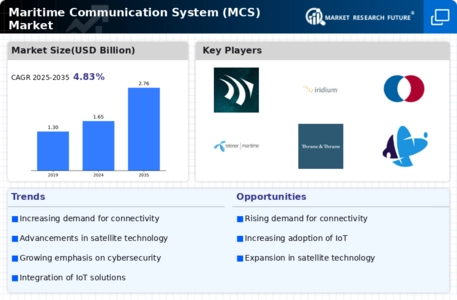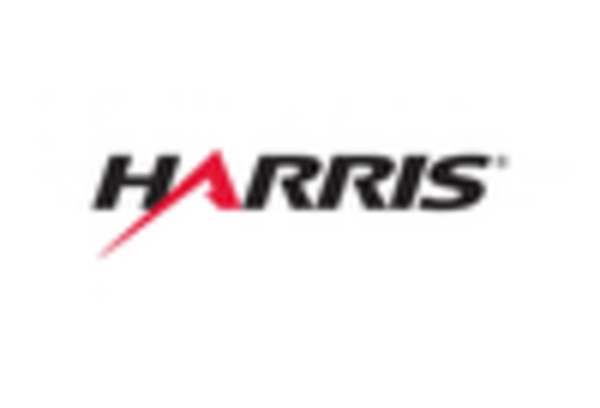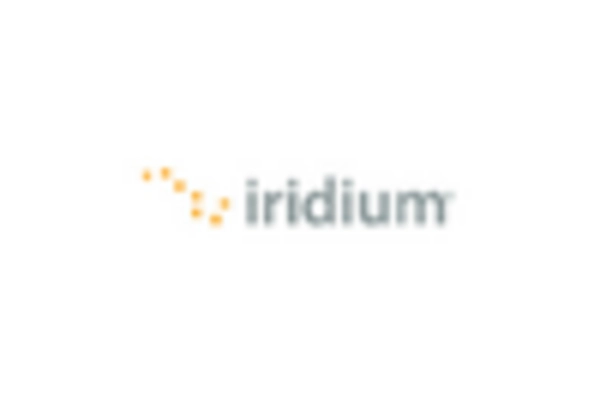Emphasis on Environmental Sustainability
The Maritime Communication System (MCS) Market is witnessing a growing emphasis on environmental sustainability, which is influencing the adoption of advanced communication technologies. As the maritime sector faces increasing pressure to reduce its carbon footprint, communication systems that facilitate efficient routing and operational practices are becoming essential. Technologies such as real-time weather monitoring and route optimization are being integrated into MCS to minimize fuel consumption and emissions. Industry reports indicate that the push for sustainability could lead to a market growth rate of around 7% in the MCS sector over the next few years. This focus on environmental responsibility not only aligns with regulatory requirements but also enhances the reputation of maritime operators in an increasingly eco-conscious market.
Integration of IoT and Smart Technologies
The integration of Internet of Things (IoT) and smart technologies into the Maritime Communication System (MCS) Market is transforming traditional maritime operations. The adoption of IoT devices enables real-time data exchange between vessels and shore-based operations, facilitating better decision-making and operational efficiency. For instance, smart sensors can monitor vessel conditions and environmental factors, allowing for proactive maintenance and reduced downtime. Market analysis indicates that the IoT segment within the MCS is projected to grow significantly, with estimates suggesting a compound annual growth rate of around 10% over the next few years. This technological evolution not only enhances communication capabilities but also supports the industry's shift towards more sustainable and efficient maritime practices.
Expansion of Maritime Trade and Globalization
The expansion of maritime trade and globalization is a key driver for the Maritime Communication System (MCS) Market. As international trade continues to grow, the need for efficient and reliable communication systems becomes paramount. The increasing volume of cargo transported by sea necessitates advanced communication solutions to ensure timely and accurate information exchange between vessels, ports, and logistics providers. Market forecasts suggest that the volume of maritime trade will increase by approximately 5% annually, further amplifying the demand for MCS technologies. This growth not only supports the operational needs of shipping companies but also enhances the overall efficiency of global supply chains, making MCS an integral component of modern maritime operations.
Rising Investments in Maritime Infrastructure
The Maritime Communication System (MCS) Market is benefiting from rising investments in maritime infrastructure across various regions. Governments and private entities are increasingly recognizing the importance of modernizing ports and shipping facilities to enhance operational efficiency and competitiveness. This trend is reflected in the substantial funding allocated for upgrading communication systems, which are critical for managing complex maritime logistics. Recent reports indicate that investments in maritime infrastructure are expected to reach several billion dollars annually, with a significant portion directed towards advanced communication technologies. As infrastructure improves, the demand for sophisticated MCS solutions is likely to increase, fostering a more interconnected and efficient maritime ecosystem.
Growing Demand for Enhanced Safety and Security
The Maritime Communication System (MCS) Market is experiencing a notable surge in demand for enhanced safety and security measures. This trend is largely driven by the increasing number of maritime incidents, including piracy and accidents, which necessitate robust communication systems. According to recent data, the maritime sector has seen a rise in the implementation of advanced communication technologies, such as satellite communications and AIS (Automatic Identification Systems), to improve situational awareness and response times. As stakeholders prioritize the safety of vessels and crew, investments in MCS are expected to grow, potentially leading to a market expansion of approximately 8% annually over the next five years. This focus on safety not only enhances operational efficiency but also aligns with the broader industry goal of minimizing risks associated with maritime operations.


















Leave a Comment